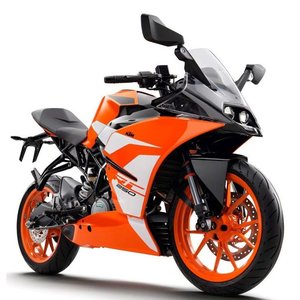KTM 250 RC [2013 - 2019]: A Track-Ready Pocket Rocket for the Street

Introduction
The KTM 250 RC, produced from 2013 to 2019, is a motorcycle that defies its displacement category. Positioned as a fully faired sportbike sibling to the Duke 250, this Austrian-engineered machine packs a punch with its lightweight chassis, race-inspired geometry, and a single-cylinder engine that thrives on revs. Designed to bridge the gap between beginner-friendly 200cc machines and the more aggressive RC 390, the RC 250 carved its niche as a "gateway sportbike" for riders craving track-day potential without overwhelming power. Let’s dissect what makes this orange-and-black missile a compelling choice for adrenaline seekers on a budget.
Design & Ergonomics: Aggressive Stance, Committed Riding Position
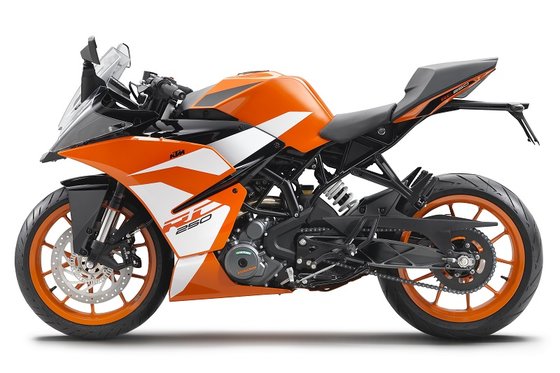
The RC 250’s design language screams "race replica." Its sharp, angular fairing—shared with the RC 390—features aggressive twin headlights, a low-slung fuel tank, and a stepped seat that locks the rider into a forward-leaning posture. The 820 mm (32.3-inch) seat height is tall for shorter riders but ideal for taller enthusiasts seeking ground clearance during cornering. The orange-painted cast alloy wheels and steel trellis frame (powder-coated for durability) add visual flair while keeping weight down to 147 kg (324 lbs) dry.
The cockpit is minimalist yet functional. A digital LCD dash provides essential data: speed, RPM, gear position, and fuel level. While later models (2017 onward) retained the same basic layout, the lack of a gear indicator or ride modes keeps the focus purely on analog riding thrills.
Engine Performance: High-Revving Single-Cylinder Symphony
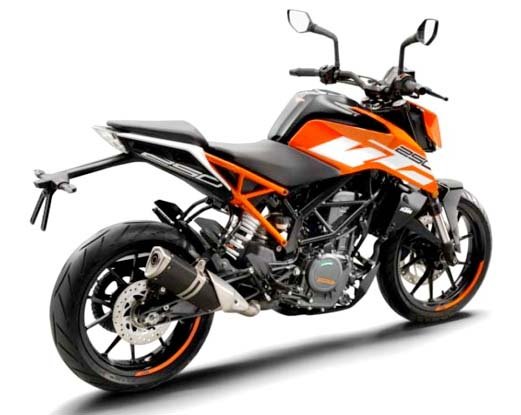
At the heart of the RC 250 lies a 248.8 cc liquid-cooled DOHC single-cylinder engine. With a 72 mm bore and 61.1 mm stroke, this oversquare design prioritizes high-RPM power delivery. The numbers tell the story: 31 HP @ 9,000 RPM and 24 Nm (17.7 lb-ft) of torque @ 7,250 RPM. While peak torque arrives relatively late, the Bosch fuel injection ensures crisp throttle response across the rev range.
The engine’s character is unmistakably KTM—vibrant, vocal, and eager to rev. Below 6,000 RPM, it feels docile enough for city commuting, but crack the throttle open past 7,000 RPM, and the RC 250 transforms into a snarling beast. The six-speed gearbox (with a slipper clutch post-2016) offers precise shifts, though the close-ratio setup demands frequent gear changes to stay in the powerband. Top speed hovers around 140-145 km/h (87-90 mph), making it highway-capable but clearly happier on twisty backroads.
Key upgrades over the years included:
- 2016: Introduction of a slipper clutch for smoother downshifts.
- 2018 SE Model: Side-slung exhaust (replacing the underbelly design) for a throatier exhaust note and minor power gains.
Handling & Dynamics: Precision Meets Playfulness
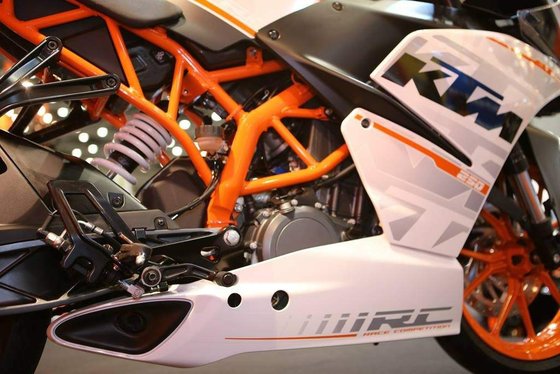
The RC 250’s chassis is where KTM’s off-road DNA shines. The steel trellis frame, paired with WP suspension, offers a stiff yet communicative setup. Up front, a 43 mm WP upside-down fork provides 125 mm (4.9 inches) of travel, while the rear monoshock (preload-adjustable) delivers 150 mm (5.9 inches). This suspension combo strikes a balance between track stiffness and street compliance—firm enough for aggressive cornering but forgiving over potholes.
With a 23.5° rake and 100 mm (3.9-inch) trail, the RC 250 feels razor-sharp in direction changes. Flicking it through hairpins is effortless, and the narrow 115/75-R17 rear tire (upgraded to 150/60-ZR17 in 2019) encourages mid-corner adjustments. Braking is handled by a 300 mm front disc with four-piston calipers (single-disc rear), backed by ABS from 2017 onward. While not as bite-heavy as premium sportbikes, the setup offers progressive feel and ample stopping power for its weight class.
Competition: How the RC 250 Stacks Up
The lightweight sportbike segment has always been fiercely contested. Here’s how the KTM fares against its rivals:
- Yamaha YZF-R25:
- Pros: Twin-cylinder smoothness, more relaxed ergonomics.
- Cons: Heavier (166 kg), less aggressive power delivery.
-
Verdict: The Yamaha suits daily riders; the KTM dominates on track.
-
Honda CBR250RR:
- Pros: Higher redline, refined electronics.
- Cons: Pricier, less torque at low RPM.
-
Verdict: The Honda is tech-rich, but the KTM feels rawer and more engaging.
-
Kawasaki Ninja 300:
- Pros: Torquier engine, beginner-friendly power curve.
- Cons: Softer suspension, dated styling.
- Verdict: The Ninja is a better all-rounder; the RC 250 is for purists.
The KTM’s power-to-weight ratio (0.21 HP/kg) gives it an edge in acceleration, while its WP suspension outclasses rivals in feedback and adjustability.
Maintenance: Keeping Your RC 250 in Peak Condition
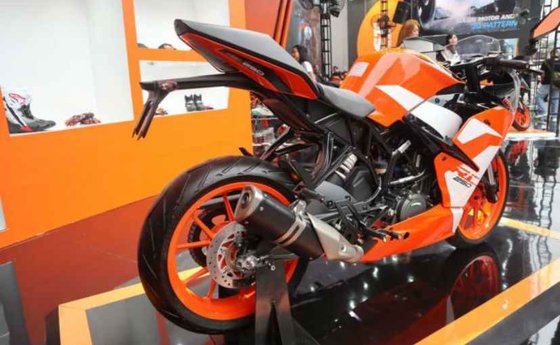
Owning a high-strung single-cylinder requires diligence. Here’s your MOTOPARTS.store maintenance cheat sheet:
- Oil Changes:
-
Use fully synthetic 10W-50 oil every 5,000 km (3,100 miles). The forced lubrication system demands quality fluids to protect the DOHC valvetrain.
-
Valve Clearances:
-
Check every 10,000 km (6,200 miles). The shim-under-bucket design isn’t DIY-friendly for novices—consider our valve adjustment toolkit for enthusiasts.
-
Chain Care:
-
The X-ring chain lasts longer but requires regular cleaning. Pair it with our high-adhesion chain lube to reduce wear.
-
Brake Upgrades:
-
Swap factory pads for sintered metal compounds during track days. We recommend EBC HH pads for improved bite.
-
Cooling System:
- Flush coolant every 2 years. Upgrade to a high-capacity radiator if frequently riding in traffic.
Common wear items to stock:
- Clutch plates (prone to slippage under hard use)
- Air filters (oiled foam type)
- Fork seals (WP-specific kits available)
Final Verdict: A Sportbike That Punches Above Its Weight
The KTM 250 RC isn’t just a motorcycle—it’s a training tool for aspiring racers and a riot for seasoned riders craving simplicity. Its combination of razor-sharp handling, addictive engine character, and race-bred aesthetics make it a standout in the 250cc class. While newer models have eclipsed it in tech, the RC 250 remains a testament to KTM’s "Ready to Race" philosophy.
Whether you’re hunting for OEM replacements or performance upgrades, MOTOPARTS.store has everything to keep your RC 250 at the apex of its potential. From WP suspension rebuild kits to Akrapovic slip-ons, we’ve got your back—no matter how hard you push it.
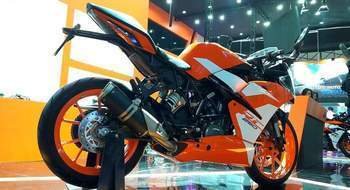




Specifications sheet
| Engine | |
|---|---|
| Stroke: | Four-stroke |
| Max power: | 24 kW | 32.0 hp |
| Max torque: | 24 Nm |
| Fuel system: | Bosch fuel injection |
| Max power @: | 9000 rpm |
| Displacement: | 249 ccm |
| Max torque @: | 7250 rpm |
| Bore x stroke: | 72.0 x 61.1 mm (2.8 x 2.4 in) |
| Configuration: | Single |
| Cooling system: | Liquid |
| Compression ratio: | 14.5:1 |
| Lubrication system: | Wet sump |
| Number of cylinders: | 1 |
| Valves per cylinder: | 4 |
| Dimensions | |
|---|---|
| Wheelbase: | 1340 mm (52.8 in) |
| Dry weight: | 147 |
| Seat height: | 820 mm (32.3 in) |
| Ground clearance: | 179 mm (7.0 in) |
| Fuel tank capacity: | 10 L (2.6 US gal) |
| Reserve fuel capacity: | 1.5 L (0.4 US gal) |
| Drivetrain | |
|---|---|
| Clutch: | Wet multi-disc slipper clutch |
| Final drive: | chain |
| Transmission: | 6-speed |
| Rear sprocket: | 45 |
| Front sprocket: | 15 |
| Primary gear ratio: | 30:80 |
| Secondary gear ratio: | 15:45 |
| Maintenance | |
|---|---|
| Engine oil: | 10W40 |
| Brake fluid: | DOT 4 |
| Spark plugs: | NGK CR8E |
| Final drive chain: | 5/8 x 1/4 X-Ring |
| Valve clearance (intake, cold): | 0.10–0.20 mm |
| Valve clearance check interval: | 24,000 km / 15,000 mi |
| Valve clearance (exhaust, cold): | 0.20–0.30 mm |
| Chassis and Suspension | |
|---|---|
| Frame: | Steel trellis, powder-coated |
| Trail: | 100 mm (3.9 in) |
| Rear tire: | 115/75-17 |
| Front tire: | 95/75-17 |
| Rear brakes: | Single 230 mm disc, 1-piston caliper (ABS) |
| Front brakes: | Single 300 mm disc, 4-piston calipers (ABS) |
| Rear suspension: | WP monoshock, adjustable preload |
| Front suspension: | WP USD Ø 43 mm upside-down fork |
| Rake (fork angle): | 23.5° |
| Rear wheel travel: | 150 mm (5.9 in) |
| Front wheel travel: | 125 mm (4.9 in) |



